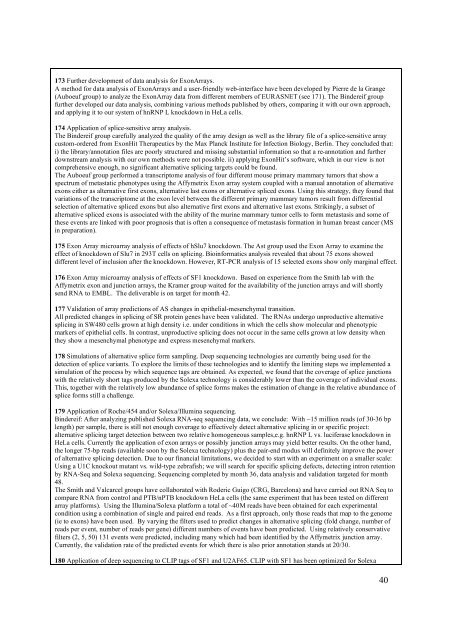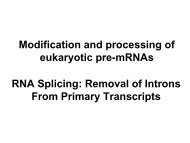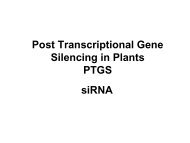Create successful ePaper yourself
Turn your PDF publications into a flip-book with our unique Google optimized e-Paper software.
173 Further development of data analysis for ExonArrays.A method for data analysis of ExonArrays and a user-friendly web-interface have been developed by Pierre de la Grange(Auboeuf group) to analyze the ExonArray data from different members of <strong>EURASNET</strong> (see 171). The Bindereif groupfurther developed our data analysis, combining various methods published by others, comparing it with our own approach,and applying it to our system of hnRNP L knockdown in HeLa cells.174 Application of splice-sensitive array analysis.The Bindereif group carefully analyzed the quality of the array design as well as the library <strong>file</strong> of a splice-sensitive arraycustom-ordered from ExonHit Therapeutics by the Max Planck Institute for Infection Biology, Berlin. They concluded that:i) the library/annotation <strong>file</strong>s are poorly structured and missing substantial information so that a re-annotation and furtherdownstream analysis with our own methods were not possible. ii) applying ExonHit’s software, which in our view is notcomprehensive enough, no significant alternative splicing targets could be found.The Auboeuf group performed a transcriptome analysis of four different mouse primary mammary tumors that show aspectrum of metastatic phenotypes using the Affymetrix Exon array system coupled with a manual annotation of alternativeexons either as alternative first exons, alternative last exons or alternative spliced exons. Using this strategy, they found thatvariations of the transcriptome at the exon level between the different primary mammary tumors result from differentialselection of alternative spliced exons but also alternative first exons and alternative last exons. Strikingly, a subset ofalternative spliced exons is associated with the ability of the murine mammary tumor cells to form metastasis and some ofthese events are linked with poor prognosis that is often a consequence of metastasis formation in human breast cancer (MSin preparation).175 Exon Array microarray analysis of effects of hSlu7 knockdown. The Ast group used the Exon Array to examine theeffect of knockdown of Slu7 in 293T cells on splicing. Bioinformatics analysis revealed that about 75 exons showeddifferent level of inclusion after the knockdown. However, RT-PCR analysis of 15 selected exons show only marginal effect.176 Exon Array microarray analysis of effects of SF1 knockdown. Based on experience from the Smith lab with theAffymetrix exon and junction arrays, the Kramer group waited for the availability of the junction arrays and will shortlysend RNA to EMBL. The deliverable is on target for month 42.177 Validation of array predictions of AS changes in epithelial-mesenchymal transition.All predicted changes in splicing of SR protein genes have been validated. The RNAs undergo unproductive alternativesplicing in SW480 cells grown at high density i.e. under conditions in which the cells show molecular and phenotypicmarkers of epithelial cells. In contrast, unproductive splicing does not occur in the same cells grown at low density whenthey show a mesenchymal phenotype and express mesenchymal markers.178 Simulations of alternative splice form sampling. Deep sequencing technologies are currently being used for thedetection of splice variants. To explore the limits of these technologies and to identify the limiting steps we implemented asimulation of the process by which sequence tags are obtained. As expected, we found that the coverage of splice junctionswith the relatively short tags produced by the Solexa technology is considerably lower than the coverage of individual exons.This, together with the relatively low abundance of splice forms makes the estimation of change in the relative abundance ofsplice forms still a challenge.179 Application of Roche/454 and/or Solexa/Illumina sequencing.Bindereif: After analyzing published Solexa RNA-seq sequencing data, we conclude: With ~15 million reads (of 30-36 bplength) per sample, there is still not enough coverage to effectively detect alternative splicing in or specific project:alternative splicing target detection between two relative homogeneous samples,e.g. hnRNP L vs. luciferase knockdown inHeLa cells. Currently the application of exon arrays or possibly junction arrays may yield better results. On the other hand,the longer 75-bp reads (available soon by the Solexa technology) plus the pair-end modus will definitely improve the powerof alternative splicing detection. Due to our financial limitations, we decided to start with an experiment on a smaller scale:Using a U1C knockout mutant vs. wild-type zebrafish; we will search for specific splicing defects, detecting intron retentionby RNA-Seq and Solexa sequencing. Sequencing completed by month 36, data analysis and validation targeted for month48.The Smith and Valcarcel groups have collaborated with Roderic Guigo (CRG, Barcelona) and have carried out RNA Seq tocompare RNA from control and PTB/nPTB knockdown HeLa cells (the same experiment that has been tested on differentarray platforms). Using the Illumina/Solexa platform a total of ~40M reads have been obtained for each experimentalcondition using a combination of single and paired end reads. As a first approach, only those reads that map to the genome(ie to exons) have been used. By varying the filters used to predict changes in alternative splicing (fold change, number ofreads per event, number of reads per gene) different numbers of events have been predicted. Using relatively conservativefilters (2, 5, 50) 131 events were predicted, including many which had been identified by the Affymetrix junction array.Currently, the validation rate of the predicted events for which there is also prior annotation stands at 20/30.180 Application of deep sequencing to CLIP tags of SF1 and U2AF65. CLIP with SF1 has been optimized for Solexa40







